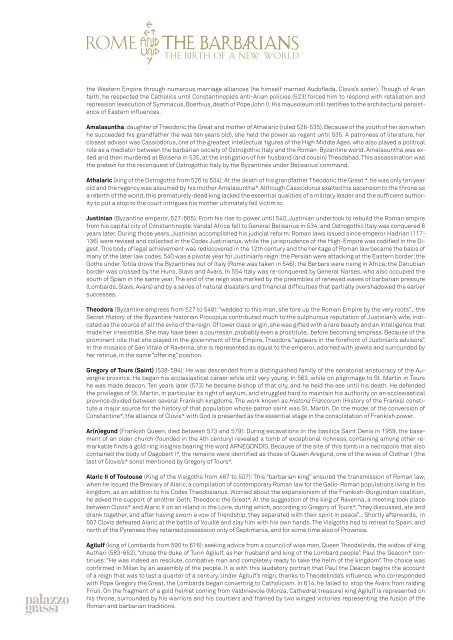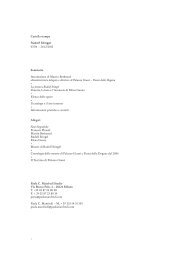pdf file, 819 Kb - Palazzo Grassi
pdf file, 819 Kb - Palazzo Grassi
pdf file, 819 Kb - Palazzo Grassi
Create successful ePaper yourself
Turn your PDF publications into a flip-book with our unique Google optimized e-Paper software.
the Western Empire through numerous marriage alliances (he himself married Audofleda, Clovis’s sister). Though of Arian<br />
faith, he respected the Catholics until Constantinople’s anti-Arian policies (523) forced him to respond with retaliation and<br />
repression (execution of Symmacus, Boethius, death of Pope John I). His mausoleum still testifies to the architectural persistence<br />
of Eastern influences.<br />
Amalasuntha: daughter of Theodoric the Great and mother of Athalaric (ruled 526-535). Because of the youth of her son when<br />
he succeeded his grandfather (he was ten years old), she held the power as regent until 535. A patroness of literature, her<br />
closest advisor was Cassiodorus, one of the greatest intellectual figures of the High Middle Ages, who also played a political<br />
role as a mediator between the barbarian society of Ostrogothic Italy and the Roman-Byzantine world. Amalasuntha was exiled<br />
and then murdered at Bolsena in 535, at the instigation of her husband (and cousin) Theodahad. This assassination was<br />
the pretext for the reconquest of Ostrogothic Italy by the Byzantines under Belisarius’ command.<br />
Athalaric (king of the Ostrogoths from 526 to 534): At the death of his grandfather Theodoric the Great *, he was only ten year<br />
old and the regency was assumed by his mother Amalasuntha*. Although Cassiodorus exalted his ascension to the throne as<br />
a rebirth of the world, this prematurely-dead king lacked the essential qualities of a military leader and the sufficient authority<br />
to put a stop to the court intrigues his mother ultimately fell victim to.<br />
Justinian (Byzantine emperor, 527-565): From his rise to power until 540, Justinian undertook to rebuild the Roman empire<br />
from his capital city of Constantinople: Vandal Africa fell to General Belisarius in 534, and Ostrogothic Italy was conquered 6<br />
years later. During those years, Justinian accomplished his judicial reform: Roman laws issued since emperor Hadrian (117-<br />
136) were revised and collected in the Codex Justinianus, while the jurisprudence of the High-Empire was codified in the Digest.<br />
This body of legal achievement was rediscovered in the 12th century and the heritage of Roman law became the basis of<br />
many of the later law codes. 540 was a pivotal year for Justinian’s reign: the Persian were attacking at the Eastern border; the<br />
Goths under Totila drove the Byzantines out of Italy (Rome was taken in 546); the Berbers were rising in Africa; the Danubian<br />
border was crossed by the Huns, Slavs and Avars. In 554 Italy was re-conquered by General Narses, who also occupied the<br />
south of Spain in the same year. The end of the reign was marked by the preambles of renewed waves of barbarian pressure<br />
(Lombards, Slavs, Avars) and by a series of natural disasters and financial difficulties that partially overshadowed the earlier<br />
successes.<br />
Theodora (Byzantine empress from 527 to 548): “wedded to this man, she tore up the Roman Empire by the very roots”... the<br />
Secret History of the Byzantine historian Procopius contributed much to the sulphurous reputation of Justinian’s wife, indicated<br />
as the source of all the evils of the reign. Of lower class origin, she was gifted with a rare beauty and an intelligence that<br />
made her irresistible. She may have been a courtesan, probably even a prostitute, before becoming empress. Because of the<br />
prominent role that she played in the government of the Empire, Theodora “appears in the forefront of Justinian’s advisors”.<br />
In the mosaics of San Vitale of Ravenna, she is represented as equal to the emperor, adorned with jewels and surrounded by<br />
her retinue, in the same “offering” position.<br />
Gregory of Tours (Saint) (538-594): He was descended from a distinguished family of the senatorial aristocracy of the Auvergne<br />
province. He began his ecclesiastical career while still very young. In 563, while on pilgrimage to St. Martin in Tours<br />
he was made deacon. Ten years later (573) he became bishop of that city, and he held the see until his death. He defended<br />
the privileges of St. Martin, in particular its right of asylum, and struggled hard to maintain his authority on an ecclesiastical<br />
province divided between several Frankish kingdoms. The work known as Historia Francorum (History of the Franks) constitute<br />
a major source for the history of that population whose patron saint was St. Martin. On the model of the conversion of<br />
Constantine*, the alliance of Clovis* with God is presented as the essential stage in the consolidation of Frankish power.<br />
Ar(n)egund (Frankish Queen, died between 573 and 579): During excavations in the basilica Saint Denis in 1959, the basement<br />
of an older church (founded in the 4th century) revealed a tomb of exceptional richness, containing among other remarkable<br />
finds a gold ring insignia bearing the word ARNEGONDIS. Because of the site of this tomb in a necropolis that also<br />
contained the body of Dagobert I*, the remains were identified as those of Queen Aregund, one of the wives of Clothar I (the<br />
last of Clovis’s* sons) mentioned by Gregory of Tours*.<br />
Alaric II of Toulouse (King of the Visigoths from 487 to 507): This “barbarian king” ensured the transmission of Roman law,<br />
when he issued the Breviary of Alaric, a compilation of contemporary Roman law for the Gallo-Roman populations living in his<br />
kingdom, as an addition to his Codex Theodosianus. Worried about the expansionism of the Frankish-Burgundian coalition,<br />
he asked the support of another Goth, Theodoric the Great*. At the suggestion of the king of Ravenna, a meeting took place<br />
between Clovis* and Alaric II on an island in the Loire, during which, according to Gregory of Tours*, “they discussed, ate and<br />
drank together, and after having sworn a vow of friendship, they separated with their spirit in peace”... Shortly afterwards, in<br />
507 Clovis defeated Alaric at the battle of Vouillé and slay him with his own hands. The Visigoths had to retreat to Spain, and<br />
north of the Pyrenees they retained possession only of Septimania, and for some time also of Provence.<br />
Agilulf (king of Lombards from 590 to 616): seeking advice from a council of wise men, Queen Theodelinda, the widow of king<br />
Authari (583-652), “chose the duke of Turin Agilulf, as her husband and king of the Lombard people”. Paul the Deacon* continues:<br />
“He was indeed an resolute, combative man and completely ready to take the helm of the kingdom”. The choice was<br />
confirmed in Milan by an assembly of the people. It is with this laudatory portrait that Paul the Deacon begins the account<br />
of a reign that was to last a quarter of a century. Under Agilulf’s reign, thanks to Theodelinda’s influence, who corresponded<br />
with Pope Gregory the Great, the Lombards began converting to Catholicism. In 614, he failed to stop the Avars from raiding<br />
Friuli. On the fragment of a gold helmet coming from Valdinievole (Monza, Cathedral treasure) king Agilulf is represented on<br />
his throne, surrounded by his warriors and his courtiers and framed by two winged victories representing the fusion of the<br />
Roman and barbarian traditions.
















